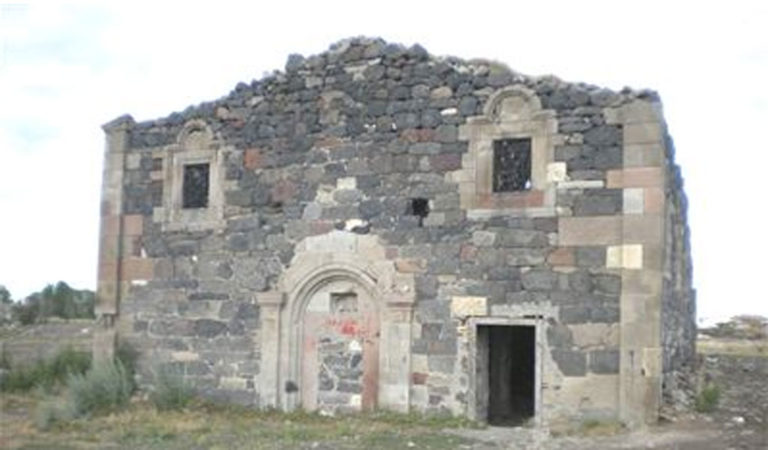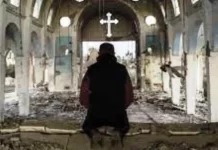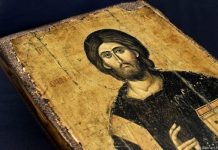Turkey: Historic Armenian Church Now Used as a Stable
Uzay Bulut/ClarionProject/April 5, 2017
The historic Armenian Surp (Saint) Minas church in the city of Erzurum in eastern Turkey is now used as a stable. The Turkish newspaper Erzurum Pusula recently covered the situation in an article titled “If you have a church, you have a nuisance!”
“There are ruins of a historic church in Gezkoy which has been nationalized,” said the report. “The Council of Monuments has recently registered it. Actually, if we leave aside its architecture that is different from the other structures there, one thousand witnesses would be needed to call it a church. It is collapsing, completely uncared for and unprotected. This church has an interesting trait. It belongs to an individual.”
According to the report, a lawyer from Erzurum “bought” the church which is located in the Aziziye town in 1934. After he died, the church passed on to his heirs. The church is now used by drunk people in the summer and as a stable in the winter.
The mayor of the town of Aziziye, Muhammet Cevdet Orhan, wants to either turn the “deserted, unused” church into a mosque or restore it, claimed the newspaper, which concluded the report by saying that “the church has caused such trouble for the mayor.”
The news site Haberler also reported in 2012 that the church was used as a stable.
The heir to the church, Sabri Ergin, lives in Germany. The newspaper Agos conducted an interview with him last year. Ergin said that he inherited the Surp Minas church from his mother, who had inherited a piece of land from his father on which the church is located. “The church cannot be used right now as there are no more congregants there,” said Ergin, who continued:
“When I went to the Armenian patriarchate, someone there told me to give the church to him. We are not distributing property here. Also, some other people wanted to buy it. They told me that some other church was sold for 1,5 million dollars but I did not sell the church.”
Ergin added that he had been threatened by the Aziziye municipality twice with destroying the church: “They told me they would destroy the church if I did not get it restored in a week. So, I got the church registered as a historical monument in 2010.” But in 2016, the municipality contacted Ergin again and told him they wanted the church to be destroyed. Ergin said that he would take the case to the European Court of Human Rights (ECHR) if the church, which also has the status of a historical monument, was destroyed.
Ergin added he prepared a project to restore the church in 2012 but he could not realize it as he could not provide the required finance: “When we prepared the project, the budget turned out to be about 500 thousand dollars. We want the church to host cultural and artistic activities… If there were even a small Armenian congregation there today, it would be much easier.”
From Karin/ Theodosiopolis to Erzurum
Erzurum, or Karin in Armenian, is a city located in the Armenian highland of eastern Turkey. It was for centuries within the borders of Armenian kingdoms. It then became a part of the Roman Empire. But the population remained pre-dominantly Armenian under the Roman rule and the city still had a sizable Armenian community under the Ottoman rule.
However, other than “Islamized” or hidden Armenian Christians whose exact number is unknown, there is not an Armenian or other Christian community in Erzurum today. It is now a fully Islamized city. There are only Turks, Kurds, and Azerbaijanis. How did this happen?
According to the International Dictionary of Historic Places: Southern Europe, “The modern city of Erzurum traces its origins to the founding of Theodosiopolis in the late fourth century. Both the Arabs and the Turks knew Theodosiopolis as Arz-ar Rum, variously translated as ‘Land of the Romans,’ ‘Domain of the Byzantines,’ or ‘Frontier of Greece,’ from which its present name is derived.”
The Turks referred to all orthodox Christian communities in Anatolia as the ‘Roman community,’ and labeled the people ‘Rum,’ meaning Roman, a term which is used until this day.
The city was a continued target of Muslim armies such as the Arabs, the Turkish tribes from the Central Asia, the Ottomans and the Turkish republic.
“Toward the end of the fourth century A.D. Roman emperor Thedosius I built a frontier fortress on the site of what is now Erzurum and named it Theodosiopolis… Theodosiopolis fell in 653 to the Arabs, who occupied the town for nearly a century… Theodosiopolis became a Byzantine dependency, called Karin, in 978, but shortly thereafter it was taken by the Bagratid Armenian kingdom of Kars.”
Turkish armies from central Asia: New frontiersmen of Islam
“In the eleventh century, a new threat appeared from the east: a Turkoman clan led by Seljukid chieftains. The Turks originally emerged in central Asia in the seventh or eighth century, began migrating westward, and encountered the Arabs in the ninth century. The Arabs had converted the majority of Turks to Islam by the end of the tenth century, and recruited them as warriors. The appearance of the Seljuk Turks in Anatolia set the stage for the decline of Roman-Byzantine-Christian rule.
“The Seljuks began raiding Byzantine territory in 1045; a large force led by Ibrahim Inal sacked Theodosiopolis in 1048. [In 1071] Seljuk sultan Alp Arslan… decisively defeated the demoralized army of Byzantine emperor Romanus VI Diogenes in Manzikert (now Malazgirt), in eastern Anatolia.
“After the battle of Manzikert, the mainly Armenian inhabited Erzurum fell to the Seljuks, and the way was left open for uncontrolled Turkoman clans – the new frontiersmen of Islam, the creators of a basically Turkish Turkey – to swarm across Anatolia.”
The imposition of the religion, language and customs of the Turks spread steadily across the region. The Seljuk Turks emerged as the champions of Sunni Islam not only against Christianity, but also against the Shia.
In 1514, the Ottoman Turks captured Erzurum from Esmail, a Shiite Turkoman clan leader. Christians in the Ottoman Empire became “dhimmis”, indigenous non-Muslim populations who surrendered by a treaty to Muslim domination.
Massacres and forced conversions
The author Robert Aram Kaloosdian, whose father was from the village of Tadem in Kharpert, which is today called Elazig in eastern Turkey, writes in his 2015 book “Tadem, My Father’s Village: Extinguished during the 1915 Armenian Genocide”:
“Heavy-handed government discriminated against non-Muslims, including Jews as well as Greeks and other Christians, and treated them with contempt and suspicion. Religious discrimination and forcible conversion to Islam wore down the Armenian population, and some communities abandoned their Christian faith.
“By the 1800s, the empty churches and monasteries across the countryside stood silent witness to a population that had left the Armenian Church out of fear and coercion. In some areas of ancient Armenia, such as the sparsely populated Dersim plateau, the locals had mostly turned to Islam to avoid persecution and the burdens of onerous taxation.”
The mid-1890s were when the Armenians were exposed to widespread massacres across the Ottoman Empire. The genocidal massacres of large numbers of Armenians were sanctioned by Ottoman Sultan Abdulhamid II between 1894 and 1897. The estimates range from a “low” of 80,000 to a high of 300,000. However, the 1915 genocide dwarfed these previous massacres and resulted in the systematic extermination of up to 1.5 million Armenians across the Ottoman Empire.
Genocide in Erzurum
The Armenians in Erzurum as well as other Ottoman cities were wiped out from their homeland by the most savage methods imaginable. Max Erwin von Scheubner-Richter, the German Vice Consul in Erzurum in 1915, describes the genocide in the city: “They killed the women, children, and elderly people by burning them to death, shearing, strangling the rivers, group shooting and rolling them from the rocks to deep rifts. Starving and frosted people were condemned to death through brutal torture. Thousands of deported Armenians were dying on the way and epidemics in deportation camps.”
Professor Ugur Ümit Üngör writes in his article “The Armenian Genocide, 1915”:
“In early 1915, 40,000 Armenians living in the city of Erzurum were deported to Der el-Zor. The German Consul in Erzurum reported in no uncertain terms that the deportation would end in ‘an absolute extermination’ (eine absolute Ausrottung). And indeed, many Armenians had already died or were seriously weakened even before the convoy from Erzurum had reached the provincial border. Once they reached the city of Kemah the survivors of the march were slaughtered and their bodies thrown into the Euphrates. The total number of Armenians from Erzurum that actually reached Der el-Zor was probably less than 200, a destruction rate of 99.3 percent.”
Ongoing cultural genocide
Since the Armenians and other Christians have largely been exterminated, it has become almost impossible to preserve the historic churches in Turkey. Many Armenian, Greek and Assyrian/Syriac churches Turkey have either been destroyed or used for sacrilegious purposes.
The researcher Raffi Bedrosyan writes: “As the Armenian population got wiped out of Anatolia in 1915, so did these churches and schools. Along with the hundreds of thousands of homes, shops, farms, orchards, factories, warehouses, and mines belonging to the Armenians, the church and school buildings also disappeared or were converted to other uses. If not burnt and destroyed outright in 1915 or left to deteriorate by neglect, they became converted buildings for banks, radio stations, mosques, state schools, or state monopoly warehouses for tobacco, tea, sugar, etc., or simply private houses and stables for the Turks and Kurds.”
Native Christian civilizations have for centuries been systematically erased from Anatolia by Turkish governments and citizens. It is high time that the West finally stood up to protect the churches and other Christian sites in Turkey that are on the verge of disappearing forever.
**Uzay Bulut is a Turkish journalist formerly based in Ankara. She is presently in Washington, D.C. Follow her on Twitter at twitter.com/uzayb





















